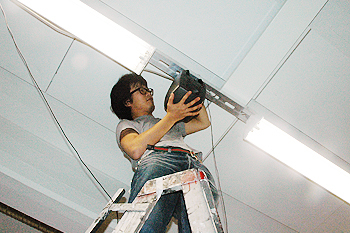An Jung Ju
Turn Turn Turn
To everything, turn, turn, turn There is a season, turn, turn, turn And a time for every purpose under heaven
A time to be born, a time to die A time to plant, a time to reap A time to kill, a time to heal A time to laugh, a time to weep
– Turn, Turn, Turn (To Everything There Is A Season) – The Byrds (1965)
On the wall of one room of a divided gallery space, a majestic building collapses in an instant, repeatedly. On the walls of the other room, manufacturing lines of a factory continue to churn something out without rest. The latest exhibition of Jungju An, entitled Turn Turn Turn, shows extinguished or used things undergoing a certain recycling process and being recreated as new things in this way, with repetition of video and sound on a huge scale, following an endless ring of circulation.
Breaking to Bits (2007), a four-channel video installation, where four, seemingly connected images are juxtaposed on one wall, features a demolition of a school building of the Songwon Foundation in Gwangju, Korea. While the sounds of laborers tearing down window frames, the ripping up of flooring materials, and an excavator destroying outer walls, all play variations on a tune with its own phonetic value, the school building which had been standing so regally, taking up the entire screen, reveals its bony structure in no time and collapse into a shroud of smoke. Breaking to Bits maintains a rather relaxed tone and tempo compared to An’s former works, and seems to reveal the artist´s impassive attitude towards the destruction of objects. This calm and dispassionate sentiment is quickly turned over by the cheerful melody and rhythms of The Bottles (2007).
A two-channel video featuring two screens installed face-to-face, The Bottles was shot in a soju (distilled Korean liquor) factory in Jangseong, where 1600 bottles are manufactured every minute. The artist has manipulated the massive dimensions of the endlessly and rapidly operating machines, and their attendant whacking noises, into a song that may be first unrecognizable but gradually gains in unmistakable familiarity. On the mechanized process of collecting empty bottles, selecting and washing reusable ones, filling them with soju, then wrapping and shipping them off again, the dizzying speed of these fast-running machines, noises of bottles crackling against each other, the thunderous sound of the machines themselves, even the imagined taste and smell of soju, offers viewers a distinctly opposite experience from Breaking to Bits and its contemplative tone.
The interesting point here is that a melody can be sensed at all in The Bottles. It´s not easy to perceive on the spot, watching the video, but those who stay in the space set up by the artist may find themselves starting to hum a particular tune at some point. Jungju An increases or decreases the speed of the recorded sounds from the actual scene, controlling the melody part with the bottle sounds and the beat section with the machine sound. He has gone one step further from previous works, in which he had divided video and sound he had recorded into certain units and repeated them in artificial and arbitrary speeds, by recreating noise into music and rearranging these noises according to phonetic values. In the room, full of stimulating sounds and chaotic images, there will come a moment when the viewer can sense a familiar melody and perhaps starts to hum. At this moment, the artist and the viewer breathe the same air and encounter a point at which an understanding of a certain situation can be shared.
Jungju An is engaged with the process of creating his own world with video and sound he has gathered in the real world, outside of his studio. Unlike former works, here he allows the units of video and sound to flow a bit more contemplatively, rather than forcibly dividing and repeating them. Nevertheless, the artist´s intention to intervene subjectively within existing objective systems and set-ups is still shown in his overall oeuvre. Through this exhibition, An’s interest in playing the noise of everyday life and ordinary scenes around him into video and sound seems to be opening up into a bigger system with grander themes, yet a cognizantly universal narrative of the process of circulation of extinction and creation roots his work. In addition, as he wishes to share his understanding of a certain situation with the viewer through the more universal realm of music, An seems to be preparing, more and more, to accept others into his world. In conclusion, the world created by Jungju An is a tool for discovering a point of understanding with the viewers and others, and his working process is a course of searching for a standard of playing video and sound, in variation.
Jungju An continues to resist and ridicule the standardized structure of the rules and systems that control individuals. It could not be just a coincidence that he chose “Turn, Turn, Turn,” a song of The Byrds, as the title of this exhibition and “Ob-La-Di, Ob-La-Da,” a song of The Beatles, as the musical variations of the machine´s noises. In the video, where the melody of the ever-optimistic chorus, ‘Life goes on,’ is being repeated, in the space where the songs that once exemplified the 1960s countercultural spirit against the establishment, is visualized, it may be read that the artist´s attitude has become more benign and accepting compared to the former works and, therefore, we ourselves may feel more at ease being invited into his world.
– Kim, Yun Kyoung (Independent Curator)

